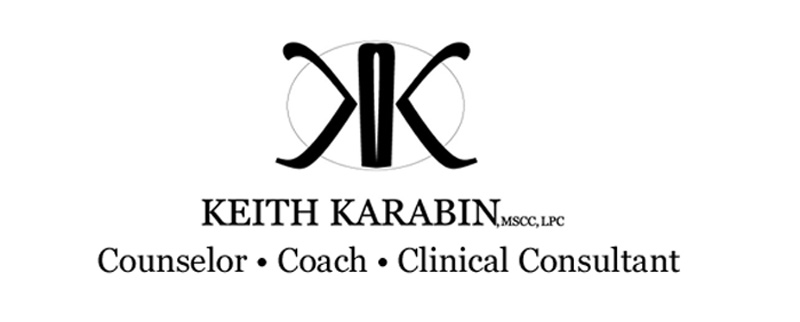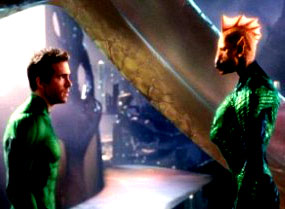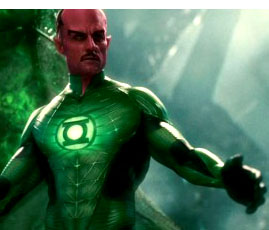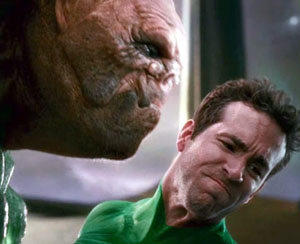The Green Lantern vs. DHS
“In brightest day, in blackest night, No evil shall escape my sight.
Let all who worship evil’s might, beware my power, Green Lantern’s light!”
– Hal Jordan
“Let all who worship evil’s might” says the Green Lantern code. All evil worshipers should beware a Green Lantern. But there’s only one for an entire sector (multiple universes) of planets and peoples. That’s an insurmountable case load, even with a ring charged with the green power of will. I began to picture scenes in my mind, as I went over the new movie with friends.
“Man, my Green Lantern’s never around when I really need him!”
“My Green Lantern’s always flying to Appelax. Exxor never gets any attention!”
“Nothing fun ever happens on F’py! Green Lantern Gk’d is always buzzing around!”
 Yes, this was over drinks. Also, deep in the irony engines of my mind, a whirring mechanism began to combine the Green Lantern Corps and Philadelphia’s own Department of Human Services.
Yes, this was over drinks. Also, deep in the irony engines of my mind, a whirring mechanism began to combine the Green Lantern Corps and Philadelphia’s own Department of Human Services.As a psychotherapist I have the opportunity to work with multiple agents of DHS. To be fair, it had also not been a good week for DHS workers—a few kids on my case load had been dealt some hefty disappointments and I’d helped the kids pick up the pieces as best they could. So I had DHS on my mind as I dissected Warner Brothers’ new DC Universe offering this past Saturday.
As quoted from the DHS Website “The primary role of DHS is to protect children who are alleged to have been abused or neglected and to ensure their safety from immediate threats and impending dangers.” I can think of no more honorable or crucial a vocation than that. It is, in its way, an analog to the Green Lantern Code above. There are few things more worshipful of evil’s (or anger’s) might than the abuse or neglect of children.
“It is important to note that, throughout the community consultation, we heard repeatedly about the effectiveness of many DHS workers…A broad cross-section of the community praised DHS workers,” according to Protecting Philadelphia’s Children: The Call to Action which was a 300 page investigative report by The Philadelphia Child Welfare Review Panel commissioned by Mayor John Street on May 31, 2007, following media reports of child deaths in DHS custody.
I will do much to praise DHS workers here, for I think they do a job that a person does not enter into for fame, money or an easy day’s work. I can’t image that anyone signs on to be a DHS worker for any other reason than to help children and families have hope and a better life. That’s valiant. Unfortunately, somewhere in the process, that valiance gets muted, tarnished and made much less effective.
If we compare the Green Lantern Corps to Philadelphia’s Department of Human services, we will find some answers to when and where valiance is beaten into complacency because both agencies struggle with similar problems and have similar strengths. Yet one is a comic book movie and the other is real hard life.
How Many Can You Help Before You Begin Hurting?
“These immortals…divided the universe into three thousands six hundred sectors. A ring powered by the energy of will was sent to every sector of universe to select a recruit…Together these three thousand six hundred recruits form the intergalactic peace keepers known as The Green Lantern Corps.”
– Tomar-Re
Let’s jump right in to what I consider the heart of the shared problem; case load. Tomar-Rae, affectionately called “Fish Guy” by our hero Hal Jordan, further defined the case loads of the 3,600 Green Lanterns with the observation that Hal’s “sector” of the universe is “a thousand times larger” than “the stars you can see from your home planet on the clearest night.”
You can tell Hal Jordan is a hero—even if he can’t yet—because he doesn’t say “that’s impossible to cover!” Even if he did, Tomar-Re concluded by saying that each of the 3,599 other Green Lanterns are overwhelmed “with a sector, just as vast.”
How could Hal keep up with the dire needs of a galaxy filled with countless inhabited planets even with a ring of power? Sure, it’s unrealistic. That’s part of how suspension of disbelief works; we simply accept some fantastical parts of the narrative.
In Philadelphia, “the Children and Youth Division (CYD) [of DHS] provides child and family-centered services to nearly 20,000 children and their families each year.” Though no data on caseload per worker was offered, we can compare a study on workload completed by Michigan DHS as they stated that “any of the problems DHS has encountered are similar to those in other major cities in the United States.”
Their findings? “Caseloads (cases per worker) have doubled since Fiscal Year 2001. The average number of cases and applications per month has grown by more than 60%, but there are 20% fewer caseworkers.” They estimated 630 cases per worker and then clarified that “We believe these estimates are low.”
Even if we round off that number to 500 cases per worker in Philadelphia, it is next to impossible to meet their most basic and “most important actions to ensure child safety… a minimum of one face-to-face contact per month with each child in its care.” Most workers got into the field to provide solid aid to those in need but how can you see 500 kids per month and give them some form of quality care?
You can’t, which is why most workers told the Child Welfare Review Panel that “DHS case loads are inequitably distributed and/or are too high—in particular, they cited the fact that a family equals a case, no matter how many children are in the family or the complexity of issues facing the family…” So now were not just talking 500 kids, but 500 families. Just like Green Lanterns are responsible for planets full of people.
This is why families in DHS care told the Review Panel that they are frustrated and demoralized by “unreturned phone calls; not showing up for family meetings and court hearings; not being willing to make family visits after hours, trying to complete Family Service Plans (FSP) over the phone; and not notifying the provider when a case is transferred within DHS” among other lesser complaints and deaths.
I struggle with this stuff, too. Sometimes leaving a voice mail for a DHS worker feels like yelling down a well. That is when I reign myself in and remind myself that their caseloads are far larger than mine. That’s just providing base-line care; phone calls and face meetings. That stuff often has to get shoved to the side in favor of countless court appearances or when kids go into crisis. Stuff that would make their green power ring blink.
Hello up There?
“While you assess, innocent lives will be lost.”
-Sinestro
Much like Hal Jordan’s frustration with the great Guardians of Oa, it is rare that decisions happen quickly with DHS and the kids who I treat often point out the logical flaws in these decisions, or at least how the reality of the decision does not mesh with the reality of their family needs.
Hal, who Sinestro has made fun of for being weak and the Guardians have hardly noticed flies in later and says, essentially “In my gnats eye-blink of time as a Green Lantern in comparison to your immortality, I’ve learned yellow fear is bad—don’t make a ring!” The guardians agree. Except for the one who makes the ring, I guess. Sheesh.
The Review Panel said that “the results of our data collection, including extensive community consultation, also all point to a pervasive theme of randomness in DHS practice” and therefore “DHS needs to reevaluate and recraft the role of supervisors.” Maybe the Child Welfare Review Panel should visit Oa.
Told but not Trained
“But I don’t need to tell you your duty. I don’t need to tell you who we are.”
-Sinestro
“I don’t need to tell you your duty. I don’t need to tell you who we are.” Sinestro said that twice in the film. Yeah, but you do. Hal was told Green Lantern lore by a fish guy in ten minutes. He was trained to use his power ring by a hairless-bison-pig guy in another ten. Abin Sur, the skinless California raisin, the ring of whom Hal inherited, told him to “say the code” but not what that code was. The Green Lantern Corps needs an HR department, that much is clear. Maybe an instructional video with a puppet. I know it was a movie and there’s always a time crunch, but is it too much to ask for an 80s montage?
The Review Panel noted similar “themes that persist and remain unresolved today; the lack of clarity of mission and purpose of the agency.” Their people don’t know the code, either.
Training is an issue as well. “Respondents also said cases that have special needs (e.g., medical issues) may not be matched with case managers who have training in these areas. In addition, some respondents reported that sex abuse cases may not be referred to the trained sex abuse unit…Accountability cannot exist in such an environment…enhance and reward good performance, and correct or eliminate poor performance.”
Sharing the Most Powerful Energy
in existence. The emerald energy of willpower…A ring powered by the energy of will
was sent to every sector of universe to select a recruit.”
– Tomar-Re
The insurmountable caseload size of DHS workers, which impedes good work, is most frustrating to me. That’s why I detailed it so deeply and what first struck me as similar between DHS and the Green Lantern Corps. However, there are strong similarities in their positive potential as well.
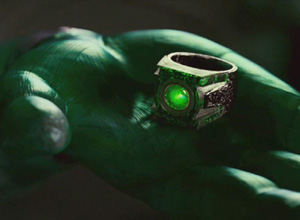 The greatest strength is the ring. “Anything I see in my mind I can create.” Hal said. “I just have to focus.” The same is true for DHS. Really. They may not have a green power ring, but they share the same visionary power. “The wide variation in practice—from front line worker to senior managers suggests that practice is what the individual worker perceives it to be.” The Panel reported. “The individual worker’s education, empathy, and level of competence, for all practical purposes, controls performance.”
The greatest strength is the ring. “Anything I see in my mind I can create.” Hal said. “I just have to focus.” The same is true for DHS. Really. They may not have a green power ring, but they share the same visionary power. “The wide variation in practice—from front line worker to senior managers suggests that practice is what the individual worker perceives it to be.” The Panel reported. “The individual worker’s education, empathy, and level of competence, for all practical purposes, controls performance.”
Just as the Green Lanterns embody the Guardians’ effort to deal with evil in the universe, DHS workers, according to the Philadelphia Department of Records, embody “the City’s efforts to deal with the human consequences of urban blight.” It is truly amazing that, night and day, these people—already burdened by hero-sized case loads—enter “stressful, frequently unsafe, and conflictual environments” armed only with the will to do good.
One DHS worker told the Panel that she continues to serve because of “the opportunity to make some kind of impact on the families, positive impact on the families. I like the ‘thank you’ that I get from the folks who feel that I helped them, or at least I know I tried to help them.”
Keeping Honor and Responsibility
“Since time immemorial the Green Lantern Corps has served as the keepers of peace, order and justice throughout the Universe. To be chosen to join its ranks is the highest of honors and the greatest of responsibilities.”
– Tomar-re
The Green Lantern makes clear that service is both an honor and a responsibility. I believe that some of the DHS workers with whom I have been acquainted, who may have been worn down by job pressure, have lost site of this. The Panel report makes clear that some “workers…do not or cannot perform in a manner that promotes the safety of children in their care.” There is no greater honor or responsibility then to serve as an agent of change or hope in a child’s life. That is a sacred trust which has been broken by countless adults in that kid’s life and one which must not be tarnished. I’ve a ton of book-learnin’, but most of my positive work is achieved by holding to that belief.
Thankfully, the Panel report also notes that “It is clear that the greatest strength DHS has is its workforce. The good work that is done on a daily basis by most of its employees must be supported.” There are those who do see service as an honor and a responsibility and who still “support for the mission of DHS and many…despite challenges…like their jobs, receive satisfaction from their work, and want to improve the system.” I’ve met one. He became the caseworker for a kid who may have been one of my toughest. He scared the kid with the power of his positive will. I am not exaggerating for sake of theme; the kid told me exactly that. He often would mention the workers “crazy intense eyes.” That worker got it.
I would offer one suggestion to DHS Commissioner Anne Marie Ambrose; show these people on your website. The “About us” page features a bio of the commissioner and some of the positive changes she’s made with DHS. That’s swell, but the families will not meet you. Show the support of the workforce by using that page to offer short, positive bios of the DHS workers who are on the street, every day. It would go far to humanize and honor them.
Best Days are Ahead
“Guardians, if your faith in our power has faltered let me re-new it…
I’ll prove to you, our best days are not behind us.”
– Sinestro
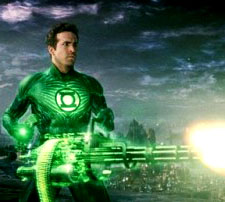 “In the fall of 2006, The Philadelphia Inquirer reported on a series of child fatalities involving families receiving services from the Department of Human Services (DHS), the agency charged with the primary responsibility for protecting children identified as being at risk of abuse and neglect. Mayor John F. Street responded by changing the leadership of the DHS and by appointing the Child Welfare Review Panel.” These are part of the preamble to the Panel report. I will be the first to say that there has been sweeping positive change in the five years since. I do believe that the best years of DHS are ahead of them, if they don’t give in to stress, insurmountable odds and the yellow power of fear and the evil which they fight every day.
“In the fall of 2006, The Philadelphia Inquirer reported on a series of child fatalities involving families receiving services from the Department of Human Services (DHS), the agency charged with the primary responsibility for protecting children identified as being at risk of abuse and neglect. Mayor John F. Street responded by changing the leadership of the DHS and by appointing the Child Welfare Review Panel.” These are part of the preamble to the Panel report. I will be the first to say that there has been sweeping positive change in the five years since. I do believe that the best years of DHS are ahead of them, if they don’t give in to stress, insurmountable odds and the yellow power of fear and the evil which they fight every day.
[Ending Spoiler Alert] The proud words of Sinestro above are ominous ones, if you stayed past the credits of the movie, or know the comic book. Sinestro loses faith, succumbs to the odds and turns from a source of hope to an agent of fear.
Did I love Green Lantern? No. It was a fun summer flick that had a great deal of fan nods—which I always respect—and wonderful special effects, but I felt it took on too much lore too fast. I dig Ryan Reynolds, and I’m glad he down-played his sarcasm in this role, but that’s much of what I enjoy about him. I had fun, but it’s no Inception.
In short, I give it 2.5 stars out of four, but that’s more than I’ve been giving the Department of Human Services, lately. DHS, please learn from The Green Lantern, and unless you’re going to start issuing green power rings, cut your caseloads so that the family contact and change which you prioritize becomes an even greater reality. Then, teach your Lanterns—I mean workers—the code.
